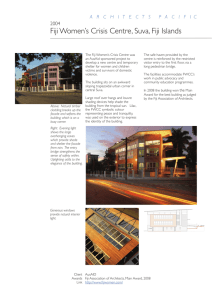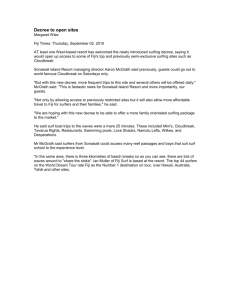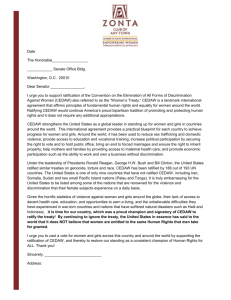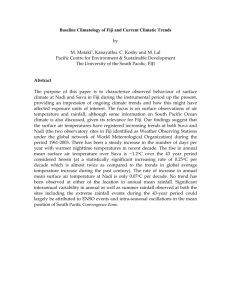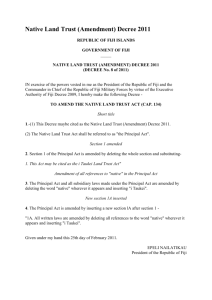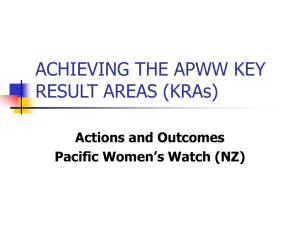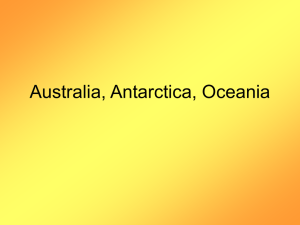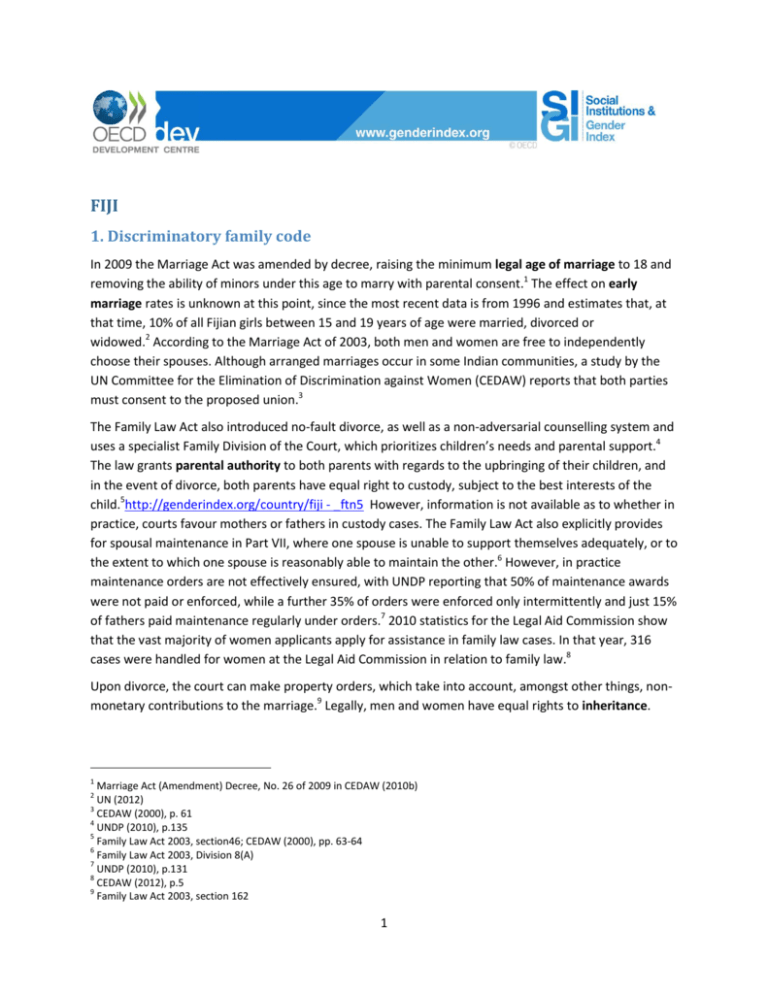
FIJI
1. Discriminatory family code
In 2009 the Marriage Act was amended by decree, raising the minimum legal age of marriage to 18 and
removing the ability of minors under this age to marry with parental consent.1 The effect on early
marriage rates is unknown at this point, since the most recent data is from 1996 and estimates that, at
that time, 10% of all Fijian girls between 15 and 19 years of age were married, divorced or
widowed.2 According to the Marriage Act of 2003, both men and women are free to independently
choose their spouses. Although arranged marriages occur in some Indian communities, a study by the
UN Committee for the Elimination of Discrimination against Women (CEDAW) reports that both parties
must consent to the proposed union.3
The Family Law Act also introduced no-fault divorce, as well as a non-adversarial counselling system and
uses a specialist Family Division of the Court, which prioritizes children’s needs and parental support.4
The law grants parental authority to both parents with regards to the upbringing of their children, and
in the event of divorce, both parents have equal right to custody, subject to the best interests of the
child.5http://genderindex.org/country/fiji - _ftn5 However, information is not available as to whether in
practice, courts favour mothers or fathers in custody cases. The Family Law Act also explicitly provides
for spousal maintenance in Part VII, where one spouse is unable to support themselves adequately, or to
the extent to which one spouse is reasonably able to maintain the other.6 However, in practice
maintenance orders are not effectively ensured, with UNDP reporting that 50% of maintenance awards
were not paid or enforced, while a further 35% of orders were enforced only intermittently and just 15%
of fathers paid maintenance regularly under orders.7 2010 statistics for the Legal Aid Commission show
that the vast majority of women applicants apply for assistance in family law cases. In that year, 316
cases were handled for women at the Legal Aid Commission in relation to family law.8
Upon divorce, the court can make property orders, which take into account, amongst other things, nonmonetary contributions to the marriage.9 Legally, men and women have equal rights to inheritance.
1
Marriage Act (Amendment) Decree, No. 26 of 2009 in CEDAW (2010b)
UN (2012)
3
CEDAW (2000), p. 61
4
UNDP (2010), p.135
5
Family Law Act 2003, section46; CEDAW (2000), pp. 63-64
6
Family Law Act 2003, Division 8(A)
7
UNDP (2010), p.131
8
CEDAW (2012), p.5
9
Family Law Act 2003, section 162
2
1
However, women have no inheritance rights to customary land and tradition favours male heirs over
their female counterparts when it comes to inheritance.10
More
While customary law is recognized under the Constitution, personal laws are not.11 Polygamy and
bigamy are illegal in Fiji as declared in the Crimes Decree of 2009.12 There is no official current data
available on the prevalence of the practice.
It must also be noted that an estimated 27% of Muslims enter religious marriages that are not legally
recognized, depriving these women of the ability to enforce legal protections on issues such as divorce,
property and custody of children.13
2. Restricted physical integrity
The Domestic Violence Decree of 2009 created a specific offence of domestic violence, defined to
include emotional, financial, physical and sexual abuse14, and removed previous requirements that a
couple attempt reconciliation before a case could be brought.15 The Decree gives police authority to
apply to a magistrate for restraining orders in domestic violence cases. The Decree also empowers any
interested members of the community to apply for restraining orders, but there have been few such
applications.16 In practice however, the government reported in 2012 that police officers and
magistrates still appear reluctant to apply for and make such civil orders. As a result, complainants are
sometimes obliged to seek legal assistance from a lawyer or NGO. 17 And there have been reports that
courts often dismiss cases of domestic abuse and incest or give perpetrators light sentences.18
The 2012 national survey on violence against women and girls also indicates that domestic violence is a
significant problem in Fiji: 72% of ever-partnered women experienced physical, sexual or emotional
violence from their husband/partner in their lifetime, and many suffered from all 3 forms of abuse
simultaneously. This includes 61% who were physically attacked and 34% who were sexually abused in
their lifetime. Rates of emotional abuse are also high: 58% of ever-partnered women experienced
emotional violence in their lifetime, and 29% in the previous 12 months before the survey.19 Moreover,
a very high proportion of women have experienced very severe physical attacks: with 44% of everpartnered women reporting having been punched, kicked, dragged, beaten up, choked, burned,
threatened with a weapon, or actually had a weapon used against them.20
There is also evidence that domestic violence is linked to pervasive gender stereotypes and norms of
male dominance. 69% of women reported having been subjected to one or more forms of control by
10
JICA (2009), p. 23; Asian Development Bank (ADB) (2008), p. 17
2013 Constitution of Fiji, Art. 186
12
Crimes Decree 2009, Decree No. 44 of 2009
13
UNDP (2010), p.128
14
Domestic Violence Decree 2009, Section 3
15
US Department of State (2011)
16
CEDAW (2012), p.8
17
US State Department (2013)
18
US State Department (2013)
19
Fiji Women’s Crisis Centre (2013), Figure 4.1
20
Fiji Women’s Crisis Centre (2013), p.3, Figure 4.17
11
2
their husband or partner, and 28% were subjected to 4 or more types of control. For example, 39% of
women have to ask permission from their husbands before seeking health care for themselves and 57%
had partners that insisted on knowing where they were at all times.21 Additionally, while 57% of women
did not agree that there were any “good reasons” for a man to hit his wife, 43% agreed with one or
more reasons for him to do so. Unfaithfulness (34%), disobeying the husband (25%) and disrespect for
the husband’s family (23%) were the main reasons that women thought justified physical violence. 14%
also thought a man is justified in hitting his wife even if he only suspects she is unfaithful, and 13%
thought it is justified if she does not complete household work to his satisfaction. Less than 1 in 10
women (9%) agreed that refusal to have sex is a “good reason”.22 Almost 3 in 5 women (58%) believe
that people outside the family should not intervene if a man mistreats his wife. These attitudes are
reflected by the fact that only 15% of women living with violence have ever gone to the police for help.23
The Crimes Decree of 2009 defines and criminalises rape in Fiji, with a maximum sentence of 10 years
imprisonment for attempted rape and life for rape, which can be tried only in the High Court.24 Spousal
rape is a criminal offence under the Domestic Violence Decree.25 Several Sexual Offences Units were
established in 1995, to enable a more effective and sensitive response in cases of sexual violence, but
the 2010 CEDAW report notes that these units are under-resourced, under-staffed, and that employees
working there are sometimes insensitive and hostile towards service users.26 In addition, women’s rights
organisations have noted that judges are inconsistent in regard to sentencing in rape cases, with
sentences usually ranging from 1 – 6 years.27 Current statistics regarding the number of rape cases
reported to the police and the number of cases that resulted in a conviction are not available.
Despite these legal protections, prevalence data indicates that sexual assault and other forms of genderbased violence are widespread throughout Fijian society. Findings from a national survey on violence
against women and girls conducted by the Fiji Women’s Crisis Centre indicate that 31% of women have
been subjected to physical and/or sexual assault since the age of 15 by someone other than their
husbands and partners. This includes 27% who were physically abused and 9% who were sexually
abused. Among those who were sexually abused, 3.5% were raped and 6.8% endured attempted
rapes.28 For 29% of women, their first sexual experience was either forced or coerced.29
According to a 2005 Australian government report, there is information to suggest that sexual violence
has been used as a weapon during flare-ups of armed and ethnic conflict in the country,30 and there is
evidence that violence against women has increased during periods of political turmoil caused by the
coups of 2000 and 2006.31
21
Fiji Women’s Crisis Centre (2013), Figure 4.22
Fiji Women’s Crisis Centre (2013), Figure 6.3
23
Fiji Women’s Crisis Centre (2013), p.155
24
Crimes Decree 2009, sections 207-209 of; US State Department (2013)
25
Domestic Violence Decree 2009, S 3
26
CEDAW (2010a), p.50
27
US State Department (2011)
28
Fiji Women’s Crisis Centre (2013), p.59
29
Fiji Women’s Crisis Centre (2013), Figure 5.11
30
Australian Government / AusAID (2005), p.2
31
United Nations Economic and Social Council (ECOSOC) (2003), p.225
22
3
Sexual harassment is prohibited under the Human Rights Commission Act.32 Under the Employment
Relations Promulgation 2008, workers can file complaints on the ground of sexual harassment in the
workplace, which may be enforced through the Employment Tribunal and Court.33 However, the US
State Department has reported that there appears to be judicial reluctance to act in sexual harassment
cases, and that the two sexual harassment complaints filed with the Employment Relations Tribunal
under the Employment Relations law in 2013 still remained pending at year’s end.34
Many women still feel restricted by cultural and social pressures that make it difficult to report genderbased violence. Noting that a high number of complaints were subsequently withdrawn by the victims, a
“no-drop” policy became standard in 2008.35 This policy aims to ensure that all reported cases receive
due legal attention, by pursuing investigations even in cases where the woman drops charges.36
However, according to the US Department of State, women’s rights organisations maintained that this
policy is not enforced consistently, and that police officers were not always aware they had the power
to apply on the victim’s behalf.
The Fiji Women’s Crisis Centre has developed a successful programme whereby male advocates are
trained to work towards the elimination of violence against women. The programme trains key
community leaders, police officers and service providers. These male advocates in turn teach other men
and boys how violence against women occurs and what can be done to prevent it. Over 100 men
graduated from the programme in Fiji, and it has since expanded to the Cook Islands, Papua New
Guinea, Tonga and Vanuatu. 37
There is no evidence to suggest that female genital mutilation (FGM) is practised in the country.
More
Abortion is legal in cases of rape and incest, foetal impairment, or when the woman’s mental or physical
health is in danger.38 According to the US Department of State, there are no legal restrictions on
women’s right to access contraception and information about reproductive health and family planning.39
Data on contraceptive use and prevalence in Fiji is scarce. According to Fiji’s 2010 UN Committee on the
Elimination of Discrimination against Women (CEDAW) report, the overall prevalence rate as of 2005
was 42%, although it is unclear to what this number refers. The report states that there is a nationwide
family planning program that offers access to contraception free of charge. They report anecdotally that
some women cannot use contraceptives because of the opposition of their spouse.40
32
CEDAW (2012), p.17
CEDAW (2012), p.17
34
US State Department (2013)
35
CEDAW (2010a), p.50
36
CEDAW (2010a), p.50
37
Fiji Women’s Crisis Centre (2012)
38
UN (2013)
39
US State Department (2013)
40
CEDAW (2010), pp. 139-141
33
4
3. Son bias
The male-to-female sex ratio at birth in 2013 is 1.05 and for the working age population (15-64 years
old) is 1.04.41
There is no evidence to suggest that Fiji is a country of concern in relation to missing women.
More
Net enrolment rates are higher for girls than for boys at both primary and secondary level in Fiji,
indicating no bias towards sons in regard to access to education.42
4. Restricted resources and assets
Women in Fiji have full ownership rights, including the same legal rights as men to inherit and access to
land and access to non-land assets.43 However, the government reported to the UN Committee on the
Elimination of Discrimination against Women (CEDAW) that women have relatively limited knowledge of
these rights and frequently accept not being recorded as co-owners in documents concerning titles or
other transactions of family assets. 44 In addition, the US State Department reports that women are
often excluded from the decision-making process on disposition of iTaukei (indigenous) communal land,
which constitutes more than 80% of all land. While women have the right to a share in the distribution
of iTaukei land lease proceeds, this right is seldom recognized.45
Fijian law provides men and women with the same access to financial services, including bank loans and
credit. In reality, access is biased towards men as they are better positioned to provide collateral and/or
an initial deposit,46 a situation hampered by the concentration of women in low-paying, less secure
occupations.47 Women in particular have been hit hard by declines in the sectors where they comprise a
majority of workers, such as tourism and the garment industry.48 In response, the Fiji Development Bank
and the Ministry of Women are taking steps to improve the situation by creating special credit schemes
for women.49 According to a United Nations Development Programme report, women also operate
nearly 20% of the 14,560 registered small and micro-businesses in Fiji.50
5. Restricted civil liberties
Under normal circumstances, women in Fiji have unlimited freedom of movement and access to public
space as guaranteed by the abrogated Constitution. Women do not need the consent of a male family
member to apply for and hold a passport, although they may be restricted from employment in
41
CIA (2014)
UNICEF (n.d)
43
CEDAW (2010a), p.100; Property Law Act of Fiji [Cap 30], Art. 21(1); Inheritance (Family Provisions) Act, Art. 3; Succession,
Probate and Administration Act, Art. 6
44
CEDAW (2000), p.60
45
US State Department (2013)
46
CEDAW (2000), p.54
47
CEDAW (2000), p.10
48
ADB (2008), p.17
49
CEDAW (2000), p.21
50
UNDP (2010), p.53
42
5
traditionally male-dominated occupations (such as mining).51 According to the 2010 UN Committee on
the Elimination of Discrimination against Women (CEDAW) report, there are no restrictions on women
joining civil society organisations (CSOs), and some of the most active CSOs in Fiji are run by
women.52 Women’s rights groups are active on issues such as reproductive health, providing human
rights training and supporting victims of gender-based violence.53 However, there have been reports of
women’s human rights defenders being harassed and detained by the military regime.54
There is no quota for women at the national or sub-national levels. There are a few women chiefs within
the traditional system of chiefs that govern parts of Fiji, but the Great Council of Chiefs (Bose Levu
Vakaturaga) has also been disbanded, and one high ranking female chief was detained in 2009.55 In 2012
the government reported to the UN Committee on the Elimination of Discrimination against Women
(CEDAW) that an obstacle to the real and meaningful participation of women in the past has been the
patriarchal nature of Fiji society. Another is the existence of cultural barriers in ensuring that women’s
voices are heard in a way in which cultural, religious and family pressures are minimised.56 United
Nations Development Programme reports that Indigenous Fijian women are still regarded as the
property of their fathers, then husbands.57
More
Fiji allows women employed in “enterprise undertakings” twelve weeks of paid maternity benefits at a
flat rate of 1.50 Fiji dollars, paid for by her employer.58 Although Section 6(2) of the Employment
Relations Promulgation 2008 prohibits discrimination on the basis of sex, pregnancy, family
responsibilities, the clear majority of women who work in the informal sector or who are not paid wages
do not qualify.59 According to the government, in 2010 the Human Rights Commission oversaw 16 cases
of gender discrimination to the courts.60
51
US State Department (2013)
CEDAW (2010a), p.7
53
CEDAW (2010a), p.41, 90
54
Women Living Under Muslim Law (2010)
55
Human Rights Watch (2009)
56
CEDAW (2012), p.4
57
(UNDP (2010), p.84
58
ILO (n.d)
59
ILO (n.d)
60
CEDAW (2012), p.6
52
6
Sources
Asian Development Bank (ADB) (2008), Gender Profiles of Asian Development Bank’s Developing
Member Countries, ADB.
Australian Government / AusAID (2005) ‘Australian aid: Eliminating violence against women’, Canberra,
ACT: Australian Agency for International Development (AusAID),
http://www.ausaid.gov.au/publications/pdf/women.pdf, (last accessed, June 2014).
CEDAW (2010a), Consideration of Reports Submitted by States Parties Under Article 18 of the
Convention on the Elimination of All Forms of Discrimination against Women: Fiji Islands, Combined
Second, Third, and Fourth Reports of States Parties, CEDAW/C/FJI/2-4, CEDAW, New York, NY.
CEDAW (2010b) ‘Responses to the list of issues and questions with regard to the consideration of the
combined second, third and fourth periodic reports Fiji’, CEDAW/C/FJI/Q/2-4/Add.1, CEDAW, New York.
CEDAW (2010c) Concluding observations of the Committee on the Elimination of Discrimination against
Women: Fiji, CEDAW/C/FJI/CO/4, CEDAW, New York.
CEDAW (2012) Concluding observations of the Committee on the Elimination of Discrimination against
Women: Fiji, Addendum. Information provided by the Government of Fiji on the follow-up to the
concluding observations of the Committee CEDAW/C/FJI/CO/4/Add.1.
Central Intelligence Agency (CIA) (2013) ‘The World Factbook: Fiji, online edition, Washington,
D.C.: CIA, https://www.cia.gov/library/publications/the-world-factbook/geos/th.html, (last accessed,
June 2014).
Committee on the Elimination of Discrimination against Women (CEDAW) (2000), Consideration of
Reports Submitted by States Parties Under Article 18 of the Convention on the Elimination of All Forms
of Discrimination against Women: Fiji Islands, Initial Report of States Parties, CEDAW/C/FJI/1, CEDAW,
New York, NY.
Fiji Women’s Crisis Centre (2012), Working with men to prevent and respond to violence against
women, available at http://webmediafast.com/fwcc/?page_id=4224 (accessed 03/09/2014)
Fiji Women’s Crisis Centre (2013), ‘Somebody’s Life, Everybody’s Business’,
http://www.researchgate.net/publication/261135545_Somebodys_Life_Everybodys_Business!_National
_Research_on_Womens_Health_and_Life_Experiences_in_Fiji_(20102011)_A_survey_exploring_the_pr
evalence_incidence_and_attitudes_to_intimate_partner_violence_in_Fiji, (last accessed, June 2014).
Fiji Women’s Rights Movements (FWRM), FWCC (Fiji Women’s Crisis Centre) and Ecumenical Centre for
Research, Education and Advocacy (ECREA) (2002), NGO Report on the Status of Women in the Republic
of the Fiji Islands.
Human Rights Watch (2009), UPR Submission Fiji’,
http://www.hrw.org/sites/default/files/related_material/HRW%20Fiji%20UPR%202009%20_3_.pdf,
(last accessed, June 2014).
7
International Labour Organization (ILO) (n.d), Database of Conditions of Work and Employment Laws,
ILO, Geneva, Switzerland (last accessed, June 2014).
Japanese International Cooperation Agency (JICA) (2009), Fiji: Country Gender Profile, JICA.
UN (2012), ‘World Marriage Data 2012’, UN Department of Economic and Social Affairs, Population
Division, New York, NY, http://www.un.org/esa/population/publications/WMD2012/MainFrame.html,
(last accessed, June 2014).
UN (2013) ‘World Abortion Policies 2013’, UN Department of Economic and Social Affairs, Population
Division, New York,
http://www.un.org/en/development/desa/population/publications/pdf/policy/WorldAbortionPolicies20
13/WorldAbortionPolicies2013_WallChart.pdf, (last accessed, June 2014).
United Nations Children’s Fund (UNICEF) (n.d.) ‘Fiji – statistics’,
http://www.unicef.org/infobycountry/fiji_statistics.html, (last accessed, June 2014).
UNDP (2010) ‘The Asia Pacific Human Development report: Power Voice and Rights: A Turning point for
Gender Equality in Asia and the Pacific’, http://hdr.undp.org/en/reports/regional/asiathepacific/RHDR2010-AsiaPacific.pdf, (last accessed, June 2014).
United Nations Economic and Social Council (ECOSOC) (2003), Integration of the Human Rights of
Women and the Gender Perspective: Violence Against Women, E/CN.4/2003/75/Add.1: New York, NY.
US Department of State (2013), ‘2012 Country Reports on Human Rights Practices: fiji’, US Department
of State, Bureau of Democracy, Human Rights and Labor, Washington, DC,
http://www.state.gov/j/drl/rls/hrrpt/humanrightsreport/#wrapper, (last accessed, June 2014).
Women Living Under Muslim Law (2010), ‘Fiji: End harassment of women human rights defenders’,
http://www.wluml.org/node/5856, (last accessed, June 2014).
World Bank (2011), ‘Global Findex’ http://datatopics.worldbank.org/financialinclusion/country/Japan,
(last accessed, June 2014).
8

